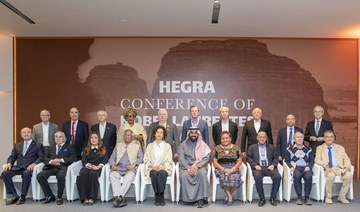ALULA: Saudi Vision 2030 has given youth the tools to achieve their goals for the next decade, the panel discussion entitled “How Youth Will Build the Next Decade” agreed.
The session was part of the Hegra Conference of Nobel Laureates and Friends 2022 held at Maraya Concert Hall on Sunday.
Richard Attias, curator of the Hegra Conference, and CEO of the Future Investment Initiative Institute, said that Saudi youth are the main assets of the Kingdom.
“The young people are not the future; they are the present; they are the main asset of the Kingdom. We are talking about the Kingdom of Saudi Arabia as the Kingdom of energy. The energy is not oil; the energy is the young Saudis,” he said.
Chairman of the King Faisal Center for Research and Islamic Studies Prince Turki bin Faisal said youth are well represented at the conference.
“Saudi youth are well represented here through Mawhiba, but also through various universities that send their students here, KAUST and other universities contributing to the discussion. Not only will they learn from the discussion here, but also I think they will be contributing to the results of this conference,” he told Arab News.
Prince Turki highlighted that a grand conference such as this is because of Saudi Vision 2030.
“The fact that we have the sterling collection of the winners of the world prizes, not just the Nobel Prize, but also the King Faisal Prize, the UNESCO Prize and other prizes, the Pulitzer Prize, all together in one place to discuss how to contribute to the welfare of humanity is the most amazing accomplishment and it is due to the Vision 2030,” he said.
“If it were not for that vision, all these people would not be here. We're grateful to his Royal Highness Prince Mohammed bin Salman for proposing the vision and, of course, to Prince Badr bin Farhan, the head of AlUla Commission. And I will not forget to mention Amr Al-Madani in his work for setting up this magnificent edifice, and all thanks go to Richard Attias for organizing this conference.”
Attias said that the youth of our current generation has an amazing power on social media.
“They are using social media as a platform for raising their voices. They are all very well educated now all over the world because they have access to knowledge thanks to precisely the internet,” he told Arab News.
“They’re not shy anymore; when they have a belief, they fight for that belief in all countries, in all continents. Not only about climate change, they are fighting for access to education, financing to become entrepreneurs, for healthcare, all social support and benefits that they need to have. I see that this young generation is probably one of the most powerful generations in the history of humanity,” he added.
Pointing to the youth in the Kingdom, he said he has known Saudi Arabia for the past 25 years and has seen their vibrance.
“I mean it. The young people are so articulate, so committed, so proud of what the Kingdom is achieving,” he said.
“They’re supporting the leadership, I see how the females of the Kingdom are so committed, and definitely, they are running the show now. They are very inspiring.”
Nobel laureates and other prominent prize-winners gathered for a three-day retreat at Saudi Arabia’s first UNESCO World Heritage Site to identify actions that can be taken to help humanity thrive in the 21st century.






























